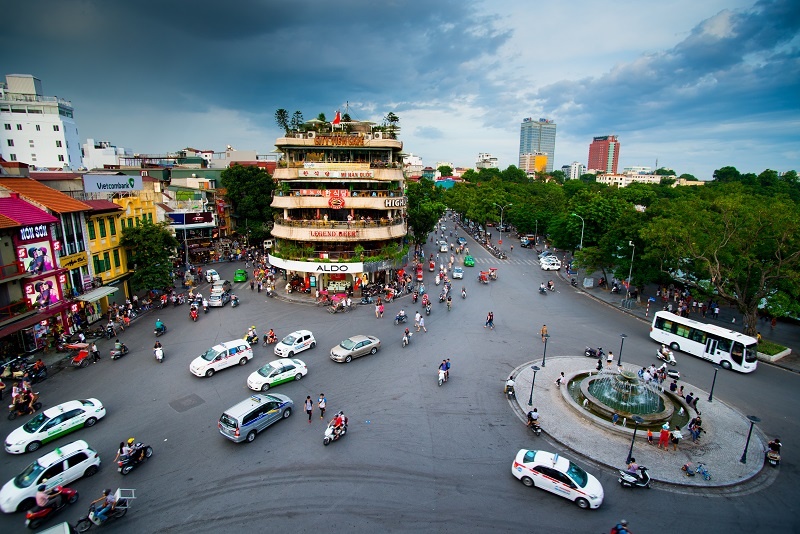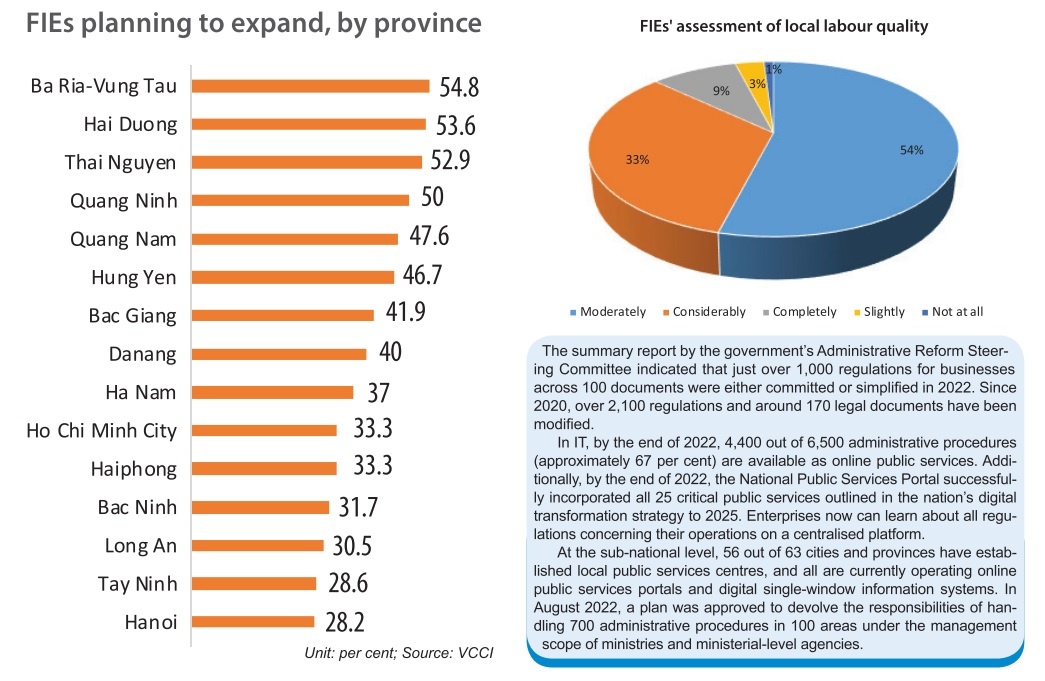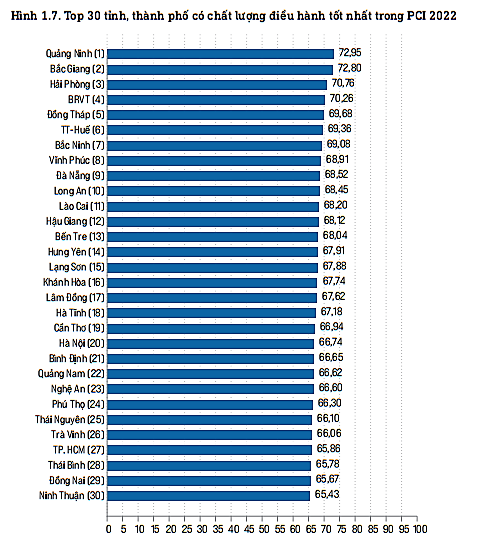Top cities bear brunt of sluggish PCI
The list of reasons for poor competitiveness by some of Vietnam’s most well-known localities is a long one. At last week’s unveiling ceremony of the latest Vietnam Provincial Competitiveness Index (PCI) and its green index equivalent, the effects of the challenging economic context were laid bare in this year’s report, as reforms in many policy areas slowed and business optimism remained low.
 |
| Top cities bear brunt of sluggish PCI, Hanoi city, Source:shutterstock |
In the report, revealed by the Vietnam Chamber of Commerce and Industry (VCCI) and with the support of the US Agency for International Development, many businesses reported multiple difficulties in access to finance, hiring employees, limited infrastructure growth, and a gap between central policy and implementation at the grassroots level.
The competitiveness of Ho Chi Minh City last year dropped by a staggering 13 places to 27th, while the capital of Hanoi slumped 10 spots to 20th position.
Ho Chi Minh City’s worst indicators were the proactivity of the local authorities, ranking second-last out of all cities and provinces, and informal charges, ranked 60th. Other indicators of the metropolis are also worse than the average level. For example, the entry costs indicator ranks 43, land access and tenure is placed 54, and law and order ranks 55 on the list.
Nguyen Dinh Tue, director of Ho Chi Minh City Centre for Supporting Small- and Medium-Sized Enterprises, said that the results of administrative reform in the city are meagre and have not created improvements for businesses.
“Most individuals and businesses still cannot carry out administrative procedures online or directly, so they pay brokerage fees. Some areas and procedures still have many bottlenecks to be solved, such as project procedures, construction permits, construction of production works on agricultural land, fire prevention and fighting, and hygiene and safety,” said Tue.
Deputy Chairman of Ho Chi Minh City People’s Committee Vo Van Hoan said that the city’s leaders have not been satisfied with the results of the administrative procedures reform index, there are still numerous shortcomings and limitations.
“There remain difficulties in the process of solving various administrative procedures. Numerous civil servants and public employees are afraid to take responsibility, and do not dare to get involved in regulations that overlap or are incomplete,” said Hoan.
About 14,000 dossiers related to land in 2022 have been delayed or feedback has been offered too late, while major transportation projects are around a decade behind schedule (such as Metro No.2 Ben Thanh-Tham Luong), or at least few years (the underpass at Nguyen Van Linh-Nguyen Huu Tho). In addition, disbursement of public investment reported poor performance compared to the national average.
Last year, Ho Chi Minh City’s regional GDP increased by 9.03 per cent, a recovery compared to before the pandemic. However, in the first quarter of 2023, it grew by only 0.7 per cent, the lowest among the five centrally-run cities.
 |
Inflexible frameworks
Up in Hanoi, the two worst indicators were entry costs and land access and tenure, both ranking 59th out of all localities and pulling down the general competitiveness of the capital significantly. Besides that, the proactivity of the city’s authorities, informal charges, and law and order are also poor at 53, 48, and 44 on the list, respectively.
Vinhomes chairman Pham Thieu Hoa stated that, although administrative reform in Hanoi has been drastically implemented, it has not yet met the true requirements.
“The city should speed up the time of administrative procedures for businesses to have more time to develop their projects. This is the most practical and necessary support action,” he said.
Dau Anh Tuan, deputy general secretary and head of the VCCI’s Legal Department, said that large economic centres are often subject to more serious economic fluctuations. Moreover, businesses and investors also expect the reforms and changes in administrative procedures there to be stronger than elsewhere.
“The enforcement quality of the local government apparatus is being underestimated, and some of them are not active or flexible,” said Tuan. “In the current challenging context, it is necessary to take the initiative of the government apparatus at all levels, especially in big cities and economic hubs. Because if only one enterprise stagnates, it may be a big risk for the local economy, or affect plenty of other ones.”
In addition to burdens caused by the challenges of the economy, foreign-invested enterprises (FIEs) have some headaches with local labour quality, expenditures on training and retention, and recent disruptions in the labour market.
The PCI survey on FIEs revealed that the typical tenure of a worker at such a business often lasts around several years. However, it has become more difficult for businesses to retain employees because workers, especially older ones, have been less interested in long-term employment and deep commitment since the pandemic emerged, according to Pham Anh Thang, representative of the Ministry of Labours, Invalids, and Social Affairs (MoLISA) in Ho Chi Minh City.
“Sometimes, workers now accumulate the time needed to receive one-time social insurance payments, which will serve as launching pads to start a business or other alternative careers,” Thang said.
FIEs battling
In the south of the country, the recruitment needs of different industries are much different. While most enterprises in textiles, footwear, wood processing, and a few other labour-intensive manufacturing industries have cut working hours since last year, the opposite can be said about manufacturing sectors such as electronics and refrigeration. For example, some top electronic component manufacturers in Saigon High-tech Park have a daily recruitment demand of hundreds of employees.
A head of the human resources department at one such enterprise told VIR that they need more than 1,000 extra employees, but since the end of January only 60 people have come on board.
Thang of the MoLISA in Ho Chi Minh City explained, “During the pandemic, two million workers left the market and many did not return. After the fluctuations of the labour market, in order to avoid risks, employers have become timid when trying to recruit, causing some obstacles in the labour market at present.”
The proliferation of decent jobs in cities and provinces up and down the country are also attracting workers away from traditional migrant labour markets such as Binh Duong and Dong Nai. Those who stay are drawn to other opportunities with comparable pay and more flexible time arrangements, such as driving for ride-sharing services or working as by-the-hour domestic helpers.
There is considerable room for improvement. For the majority of FIEs (54 per cent), labour quality in their provinces only moderately met their needs. About one-third of the survey’s respondents reported that labour quality considerably met their needs. Only 9 per cent were completely satisfied with the local workforce, down from 15 per cent in 2021.
However, when considering the quality of the future labour force, firms’ outlook seems to be optimistic, according to the PCI survey. FIEs are positive about the quality of general education and vocational training for would-be workers. They rate general education at 4.5 and vocational training at 4.4 out of six points in total.
“Improvements in labour quality are urgently needed since labour productivity needs to keep up with wage increases for Vietnam to remain an attractive destination for both foreign and local businesses,” urged Thang.
In 2022, FIEs recovered steadily from the negative impacts of the pandemic. The share of FIEs hiring new employees increased markedly from 50.56 per cent in 2021 to 55.77 per cent last year. While 2021 saw an unprecedentedly low rate of businesses reporting profits (38.72 per cent), FIEs improved in this metric in 2022 at 42.77 per cent. Foreign investors appear to have adjusted their operations to stabilise income and expenditures. The shares of businesses reporting losses dropped from a record high of 47.9 per cent in 2021 to 44.88 per cent last year.
Pham Tan Cong, chairman of the VCCI, stated that businesses are facing multiple obstacles from the challenging economic context. “We hope local authorities will strengthen support policies that contribute to a more enabling and stable domestic business environment to make up for the instabilities of the global market for the business community,” he said.
 | PCI 2022: Bac Giang improves significantly as two biggest cities drop The Provincial Competitiveness Index (PCI) and new Provincial Green Index (PGI) have honoured Quang Ninh for the sixth consecutive year and Tra Vinh for the first time. |
What the stars mean:
★ Poor ★ ★ Promising ★★★ Good ★★★★ Very good ★★★★★ Exceptional
Related Contents
Latest News
More News
- Sembcorp Development secures licence for VSIP in Khanh Hoa (December 31, 2025 | 18:54)
- New decree sharpens enforcement in securities market (December 31, 2025 | 18:53)
- Green transition to close $20 billion annual investment gap (December 31, 2025 | 11:59)
- FPT exports first chip shipment to Japan (December 31, 2025 | 10:47)
- AkzoNobel rolls out sustainability campaign “It All Adds Up” for the wood sector (December 31, 2025 | 09:23)
- Gold market reform advances as SBV receives applications for bullion production (December 30, 2025 | 12:07)
- T&T Group brings Savan 1 Wind Power Plant online in Laos (December 30, 2025 | 12:05)
- Australia contributing to Vietnam’s climate change responses (December 30, 2025 | 11:37)
- CME Solar strengthens position in Vietnamese renewables (December 30, 2025 | 11:21)
- Textile apparel firms deliver robust earnings despite global tariff pressures (December 30, 2025 | 10:09)

 Tag:
Tag:




















 Mobile Version
Mobile Version